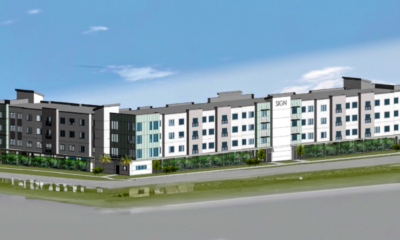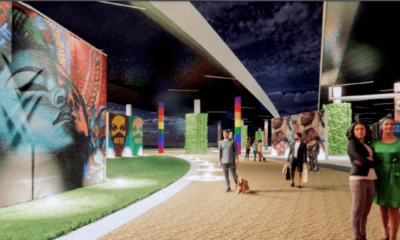Comm Voice
Community Voices: Environmental injustice, Salt Creek and the bigger CHHA picture

Welcome to the Catalyst’s Community Voices platform. We’ve curated community leaders and thinkers from all parts of our great city to speak on issues that affect us all. Visit our Community Voices page for more details.
Soon St. Pete City Council meets again, listening attentively to the possible future merits of Mayor Rick Kriseman’s request to vote for a comprehensive set of very technical plan amendments to our existing laws. These were previously well-developed with full and open public in-person hearings.
Having full sympathy for their dilemma, as we are forced to attend this public hearing by phone or Internet, also trying to understand why we NOW need such new rules allowing for increased residential density in the Coastal High Hazard Area (CHHA).
When the mayor granted time for more public education and conversation, a group was born spontaneously of an uncoordinated collection of mutli-racial, mutli-generational Southsiders and urban pioneers, either past and/or current – some highly educated with great jobs, some not so educated enough and/or in need of a better job, or worse yet … any job.
Although college-educated with two degrees, I still find myself wishing for a good magic decoder ring out of a cereal box to help me better to decipher all the acronyms and technical concepts that the mayor has had developed by his taxpayer-funded staff and/or outsourced consultants.
Let’s try to decode these supposedly VERY important secret codes:
Community Rating System (CRS), Insurance Services Office, Inc. (ISO), Class 7, NFIP Community Rating System (CRS), ISO/CRS Specialists (do we need some?), LDRs, Criterion G, City Policy LU 7.1, Policy CM 10A Community Rating System VS FEMA (Does a long name mean it is VERY important?), and a Community Rating System VS CM Policy 10.
- What exactly is the difference between Resilience Quotients and Resiliency? How good will the new set of zoning regulations be in this regard?
- How many state-earned credits will get if we have a really good floodplain manager? Does the City have such a person?
- How many state-earned credits we will get if the amendments pass?
- Is the City in the CRS?
- Has the City completed their CRS Elevation Certificate Checklist?
- Has the City yet met our Limit of Moderate Wave Action (LiMWA)?
- Do we also need to worry about an EF-2 tornado?
- Is a taller building better to generate the proper ratios to create more affordable housing…if so for whom … what is affordable ... $1,500 per month rent? Who will be considered eligible?
We all are just as confused by the environmentalists who oppose the mayor for what seems like really very good reasons, but they too speak in codes: What exactly is a SLOSH computerized storm surge model hurricane … a really bad one?
Our city councilors also seem so concerned with gentrification. Is so bad like some say … or is it good, and if so, for whom? Many of us have lived here for many years; we were too poor or dark in skin color to live north of Central. Some of us instead are urban pioneers, choosing to live in Southside!
Oh, so many techie codes to understand!

We hope that all parties involved could should more aware of the importance of environmental justice and/or when lacking … environmental injustice.
We Southsiders wish to share very briefly our plan’s sample view on how the inclusion of environmental justice should be used in all of the community’s now and future considerations to more effectively frame and simplify the important public dialogues on land planning and zoning. The residents deserve to have the possible societal impacts easily understood. Hopefully we can define this concept so no decoder rings will be needed:
It is not, however, simply that there exists unhealthy and unsafe conditions of vegetation, trash, and litter in or surrounding Salt Creek. It is the unhealthy environments in which people and families may find themselves, too many times, just living there as result of their race and/or economic situations.
As a result of the country’s current overall increased sensitivity in general to the concepts of racial and economic injustices, environmental injustice will now become under greater public and government scrutiny.
According to the Vermont Journal of Environment Law:
There is empirical evidence that environmental injustice is caused by many factors, including discriminatory siting, misguided regulatory policy, unequal regulation enforcement, and unequal political power. These factors do not function independently. Low-income and minority communities are often more likely to have less political power, and communities with less political power less likely to have their voices heard by regulators. However, research that establishes each factor’s role in creating incidents of environmental injustice lends credence and actionability to the environmental justice movement. With empirical proof of its causes, policymakers have multiple avenues through which they can combat environmental injustice.
Probably the most familiar example is the Flint, Michigan water crisis. This public health crisis started in April, 2014, after the drinking water source for the city was changed from treated Detroit Water and Sewerage Department water to the Flint River.
The environmental injustices that have occurred in and around Salt Creek, all the way down to Lake Maggiore, were caused by many factors more than 100 years ago. According to B. Bruce Stephenson’s Visions of Eden (p. 61), they occurred when up to three story building supporting storage and warehouses occupied most of the land zoned for industrial uses that lay along the railroad and near the terminal (ship) at Bayboro Harbor.
Nevertheless, we believe that the country’s new sensitivity to prior historic economic injustices created years ago with little or no current responsibility now involved could well assist Saint Petersburg when considering potential zoning and land planning changes. As a result of this current attention, many additional environmental mitigation funding opportunites will become available. We believe that the adoption of our Southsiders’ developed plan will greatly advance those opportunites.
Our plan is based upon a need to demonstrate a long overdue respect for this area’s nature tropical environmental wonders. Especially in these stressful times, as the residents who have traditionally lived, worked, and played closest to these sources of pollution, we desire more additional opportunites for safe and healthy recreation.
We believe that our plan based upon environmental justice will not only help to create a salve for the battered soul of our community, but also begin to create The Southside Golden Circle. At its very core is our creation of the Salt Creek Preserve – the environmental mitigation and transformation of the Salt Creek area, up to and including Lake Maggiore.
This plan relies heavily upon the original concepts presented to the City in 1923 by John Nolen, who many considered a kindred spirit whose visions of urban reform helped pioneer the planning profession.
Fredrick Law Olmsted, Jr, Nolen’s mentor at Harvard University’s School of Landscape Architecture, introduced him to the idea that planners could unify the complex elements comprising the organic city. Nolen thus recommended that a system of paths and parkways connected public lands, so that urban dwellers enjoy the beauty and wonder of nature [sic] world.








Sue Thomas
August 27, 2020at12:52 pm
I certainly support the concept of a Southside Golden Circle! While I am in favor of development & redevelopment (particularly for affordable housing), it is critical to be respectful of, and to protect, our natural resources. Overbuilding can cause flooding, the destruction of wildlife and their habitat, and remove greenery and eliminate our “wild places”. Let’s enhance and maintain our beautiful jewel of St Pete. Most importantly, that includes sustaining our abundant natural resources now and for years to come.